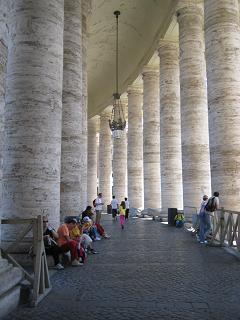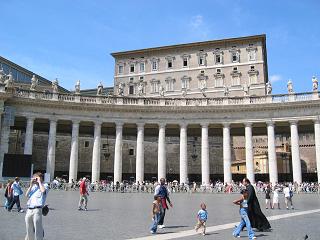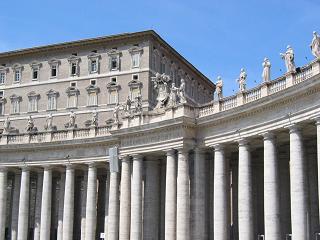|
|
 |
|
St. Peter's Piazza |
|
written
by minhan / 09.22.2005 |
|
|
| |
Description |
| |
| |

|
| www.italycyberguide.com |
| St. Peter's Piazza |
| An aerial view of the piazza. |
| |
|
| |

|
| Photo by Minh-An Nguyen |
| Egyptian Obelisk |
| The obelisk stands tall today in the piazza. |
| |
|
| |

|
| Photo by Minh-An Nguyen |
| The Great Colonnades |
| An image of the inside the arms of the colonnades. |
| |
|
| |

|
| Photo by Minh-An Nguyen |
| Optical Illusion |
| The incredible illusion. Standing on a marble disc labeled "Centro del Colonnato," the four columns appear like one. |
| |
|
| |

|
| Photo by Minh-An Nguyen |
| Saints and Martyrs Welcome All in |
| The statues line the colonnades beautifully. |
| |
|
The general shape of the piazza is composed of an oval area, the Piazza Obliqua, and a trapezoidal area, the Piazza Retta. There is a clear central axis that leads straight to the basilica. At the center of the Piazza Obliqua stands the Egyptian Vatican Obelisk. Bernini used the obelisk as the centerpiece for the piazza. The 25.5 meters tall obelisk originally from Egypt was moved to Rome in the 1st century AD (37AD) and later moved to its current position in 1586 by Sixtus V. The obelisk in the piazza is an important element to the Catholic community. At the top of the obelisk, Constantine put a relic from the True Cross. It is also believed that the obelisk once stood in the same place where St. Peter was crucified, Nero’s Circus. There are many coat of arms and symbols representing the various patrons that played a major role in the basilica and the piazza. The most noticeable is the Chigi star representing the family of Pope Alexander VII. There are also pictures of mountains and star of Sixtus V. Surrounding the obelisk are stone-relief ellipses symbolizing a mariner’s compass with carvings of various winds. On either side of the obelisk lies a fountain. The designer of the façade Carlo Maderno designed one of the fountains, which contains the eagle of Borghese, and Bernini added the other fountain to provide symmetry. Bernini used these fountains as the foci of the oval made by his colonnades.
In the 16th century, the use of cobblestones was first adopted to pave the area of St. Peter’s Piazza. Cobblestones are actually also called Sampietrini, which literally means “little stones of St. Peter’s” and were first used in the piazza before the usage expanded to the rest of Rome. The pavement today is not the original cobblestones because in 1817, the obelisk was used to also function as a gnomon. A gnomon is a device that can be used to tell the day of the year. At noon the obelisk casts a shadow that lines up with various discs of white marbles, which had to be added. These marbles have figures of the Zodiac and represent the cardinal points of the compass.
The defining characteristic of the piazza are the 284 travertine thirty-nine feet colonnades, which frame the piazza. Bernini originally wanted to also add a third arm, terzio braccio, a triumphal arch, to connect the colonnades but the plan was not completed due to monetary limitations. The piazza is surrounded by these two colonnades, creating an elliptical shape that is 320 m long and 240 m wide. The Doric colonnades are four columns deep down the arms of the colonnades, which creates three continuous passages, two for pedestrian and one for carriage. This theme of three aisles was commonly used to represent the approach to the apse in churches. The passageways were used for various ceremonial processions and also provided shelter from sun, wind, and rain. Bernini’s talent is best exemplified when looking at the placement of the columns. The columns are “radially aligned, as though set along the spokes of a wheel whose hubs are points located between the fountains and the obelisk.” The ingenuity of the exact placement of the column and the location of the center and foci allowed for a “visual elasticity between side and central elements” or a kind of smoothness in the connection between the side and central spaces of the piazza. Also Bernini’s colonnades had more strength because of his unique and unorthodox decision to put an Ionic entablature, the unit above the colonnades, on the Doric colonnades. This combination gave strength to the columns and gave a pleasing contrast to the slender Corinthian columns of the façade. Another unique design of Bernini was to build temple fronts ending with a portico in the middle of each of the two colonnade arms. The portico has a giant coat of arms of Alexander VII, mountains and oaks. These porticoes allowed the colonnades to be less monotonous but still have a natural flow.
Above the colonnades on the Ionic entablature lie 96 statues, 15 feet in height, each designed by Bernini. The statues include the most famous saints and martyrs of the church. Fifty two statues were finished during Pope Alexander’s time while the rest were finished during Pope Clement XI’s time. These statues welcome the pilgrims into the piazza and guide the pilgrim to the basilica.
Another component of St. Peter’s Piazza is the Piazza Retta. The colonnades from the Piazza Obliqua are connected to the corridors of the Piazza Retta with the use of pillars with oblique edges. The pillars allow a very smooth transition between the “curved geometry of the colonnades to the linear geometry of the corridors.” The corridors of the Piazza Retta line each side of the path leading to the basilica. The size of the corridors is very deceptive because although they look small, the length of the corridor is similar to the arms of the colonnades. The colonnade and the corridors contrast each other, and it is this contrast that makes each component very complimentary. The corridors create a very firm and focused emotion when walking up to the basilica, while the colonnade creates a very open and gentle path emerged with “light, atmosphere, and intermittent view of buildings beyond.”
|
| |
|
| |
|
|
 |
|

